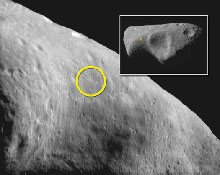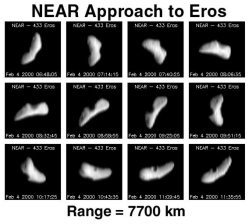This is a group of photographs taken of Eros by the NEAR spacecraft during its approach.
Click on image for full size
The Johns Hopkins University Applied Physics Laboratory, Laurel, Maryland.
NASA is Getting NEAR Eros
News story originally written on February 9, 2000
The Near Earth Asteroid Rendezvous (NEAR) spacecraft is heading towards the asteroid, Eros. It is scheduled to begin its orbit around the giant rock on Valentines Day, February 14th.
This will be the first time a spacecraft has been sent to an asteroid.
Scientists say the NEAR craft is right on course. Although actually getting the craft into orbit won't be easy, keeping the orbit without crashing into the asteroid is even trickier. Eros has an
unusual shape and rotation. Scientists have to watch the craft and asteroid closely, and maneuver NEAR so it doesn't crash.
"No one has ever orbited a small body in
space," says Dr. Robert Farquhar, NEAR mission director. "The orbital stability is rather tenuous, and as we travel
around Eros our navigation maneuvers must be perfect to keep us from crashing into it."
NEAR will study the composition and history of Eros. It will also determine whether or not Eros has a magnetic field. Scientists are also hoping to spot any moons that may be circling the rock. Eros is one of the
largest asteroids known. Eros is estimated to be 23 * 8 * 8 miles, about twice the size of Manhatten Island.
You might also be interested in:

The force of magnetism causes material to point along the direction the magnetic force points. This property implies that the force of magnetism has a direction. As shown in the diagram to the left, the
...more
The NEAR spacecraft has been in orbit around the asteroid Eros since Valentine's Day of last year. It has met all of its science goals. It has been a huge success within NASA's low-cost planetary exploration
...more
It was another exciting and frustrating year for the space science program. It seemed that every step forward led to one backwards. Either way, NASA led the way to a great century of discovery. Unfortunately,
...more
The Space Shuttle Discovery lifted off from Kennedy Space Center at 2:19 p.m. EST, October 29th. The sky was clear and the weather was great as Discovery took 8 1/2 minutes to reach orbit for the Unitied
...more
A moon was discovered orbiting the asteroid, Eugenia. This is only the second time in history that a satellite has been seen circling an asteroid. A special mirror allowed scientists to find the moon
...more
Will Russia ever put the service module for the International Space Station in space? NASA officials are demanding an answer from the Russian government. The necessary service module is currently waiting
...more
During a period of about two days in early May, 1998, the ACE spacecraft was immersed in plasma associated with a coronal mass ejection (CME). The SWICS instrument on ACE, which determines unambiguously
...more















